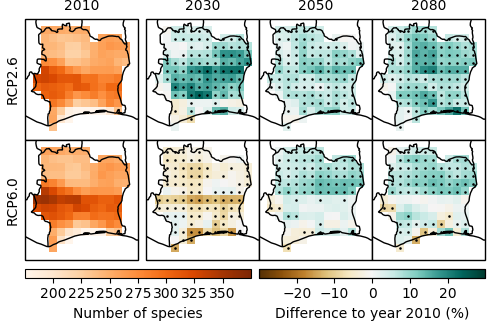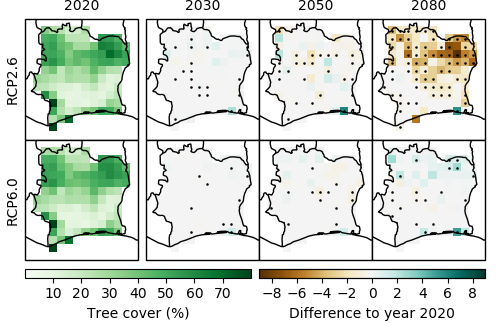Côte d’Ivoire: Ecosystems
Climate change is expected to have a significant influence on the ecology and distribution of tropical ecosystems, even though the magnitude, rate and direction of these changes are uncertain [33]. With rising temperatures and increased frequency and intensity of droughts, wetlands and riverine systems are increasingly at risk of being converted to other ecosystems with plant populations being succeeded and animals losing habitats. Increased temperatures and droughts can also impact succession in forest systems while concurrently increasing the risk of invasive species, all of which affect ecosystems. In addition to these climate drivers, low agricultural production and population growth might motivate further agricultural expansion resulting in increased deforestation, land degradation and forest fires, all of which will impact animal and plant biodiversity.
Species richness

Model projections of species richness (including amphibians, birds and mammals) and tree cover for Côte d’Ivoire are shown in Figure 16 and 17, respectively. Projections of the number of animal species show an increase by 2080 (Figure 16): Under RCP2.6, models agree that the number of animal species will increase by up to 20 % all across Côte d’Ivoire. Under RCP6.0, models agree on a similar trend, yet only for the northern part of the country.
Tree cover

With regard to tree cover, model results are far less certain. For RCP2.6, there is model agreement on a decrease in tree cover in small patches across all of Côte d’Ivoire. For RCP6.0, however, model agreement is low and no clear trend can be identified (Figure 17).
It is important to keep in mind that model projections exclude any impacts on biodiversity from human activities such as land use, which have been responsible for significant losses of global biodiversity in the past, and which are expected to remain its main driver in the future [34]. For example, rapid growth of agricultural production, uncontrolled fires and logging have resulted in one of the highest rates of deforestation worldwide: Côte d’Ivoire has lost 3.03 million hectares of forest cover in the period from 2001 to 2019, which is equivalent to a 20 % decrease [15].
References
[15] Global Forest Watch, “Côte d’Ivoire.” Online available: www.globalforestwatch.org [Accessed: 27-Jan-2020].
[33] T. M. Shanahan, K. A. Hughen, N. P. McKay, J. T. Overpeck, C. A. Scholz, W. D. Gosling, C. S. Miller, J. A. Peck, J. W. King, and C. W. Heil, “CO2 and Fire Influence Tropical Ecosystem Stability in Response to Climate Change,” Nat. Publ. Gr., no. July, pp. 1–8, 2016.
[34] IPBES, “Report of the Plenary of the Intergovernmental Science-Policy Platform on Biodiversity and Ecosystem Services on the Work of Its Seventh Session,” n.p., 2019.


